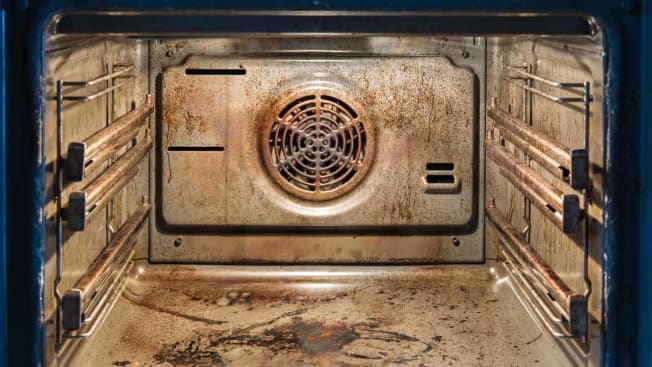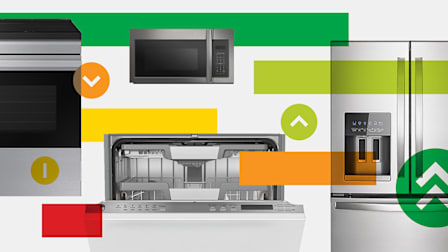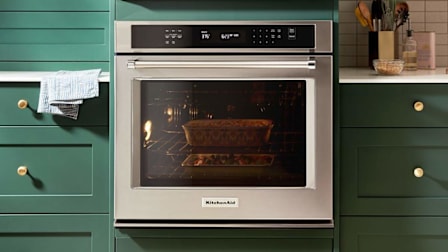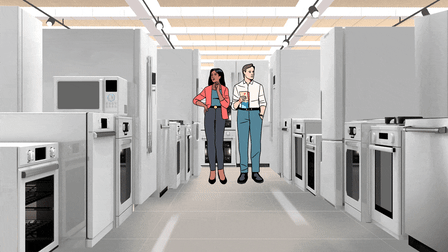Is It Safe to Run Your Oven's Self-Clean Cycle?
CR’s in-house range experts offer their take on what might be your stove's most hotly debated feature
When you shop through retailer links on our site, we may earn affiliate commissions. 100% of the fees we collect are used to support our nonprofit mission. Learn more.

The self-clean cycle might be your stove’s most feared and revered feature, depending on whom you ask.
The allure? A self-cleaning oven gets the cavity squeaky clean without a drop of chemical cleaner—and without much elbow grease. It achieves this feat by heating to temperatures north of 800° F to burn off baked-in spills and spots, leaving you with a thin layer of white ash that’s easily wiped off with a sponge.
Don’t Let the Horror Stories Scare You
Despite those aforementioned anecdotes, self-clean disasters are the exception, not the rule. Sutton has seen little evidence to suggest that running the self-clean cycle is likely to damage your oven. “I recall hearing of a few malfunctions during self-cleaning over the years, but it’s not a common thing,” he says. In fact, such problems emerge in only 1 percent of the self-cleaning ranges covered in our most recent reliability ratings. Ignition problems, unrelated to self-cleaning, are far more likely, occurring in 8 percent of gas and pro-style ranges. The same holds true for cooktop chips and scratches, which occur with roughly eight times the frequency of broken self-clean cycles.
Chris Zeisler, technical service supervisor at Repair Clinic, says it’s possible that certain parts might break or malfunction during a self-clean cycle, including door latches, electrical components, bake or broil elements, igniters (in gas ranges), and gaskets. “The biggest takeaway is that if you’re hosting a big gathering, like Thanksgiving, you want to run the cycle several weeks in advance,” he says.
How We Test the Self-Clean Cycle on Ovens
To test self-cleaning ovens in CR’s labs, we make a proprietary mixture of messy foods that might soil an oven cavity, including tapioca, cheese, tomato purée, lard, and cherry pie filling. We paint that mixture onto the oven cavity, walls, and door and bake it to make it tougher to remove. Then we run the self-clean cycle, and our pros judge how well it cleans, based largely on how much scrubbing needs to be done afterward. In general, these cycles do a pretty good job. “When the cycle works well, it’s really just incredible how clean the cavity gets,” Collomb says.
Using the Self-Clean Cycle Requires Precautions
Those same high temperatures that help your oven clean can produce smoke and fumes. “When you run the cycle, turn on a range hood if you have one and open some windows,” Collomb says. If you have an air purifier, running it at the same time may help as well.
Remember, too, to keep the top of the stove clear. “It can get really hot,” Sutton says.
The oven door will lock for the entire cycle, which takes about 3 to 5 hours, depending upon the model. Keep that in mind, because if you start the self-clean cycle later in the day, it might be a good night to order a pizza. And keep kids and pets out of the kitchen.
Self-Clean Is Different From AquaLift
Self-cleaning cycles are the norm, but you won’t find them on every model. “Some very inexpensive models don’t have self-cleaning features,” Sutton says, “and a number of pro-style models also forgo the cycle”—so you’ll have to scrub the interior clean by hand.
You’ll see some models with an AquaLift setting, a light-duty steam-clean cycle that’s common in brands owned by Whirlpool (including Amana, KitchenAid, and Maytag). In our tests, these cycles are no match for high-heat self-clean cycles. They generally can work on loosening very light spills or debris on the oven floor, which may be helpful if you’re cleaning up, say, cake-batter splatter immediately after a messy baking session.
You Still Have to Do a Little Work
Self-cleaning doesn’t mean fully automated. For starters, you’ll need to remove the racks and clean those by hand. Running the self-clean cycle with the racks in place can cause them to discolor and may remove the factory finish that helps them glide smoothly. (But if you run the cycle by accident without taking the racks out, don’t despair—just try rubbing the racks down with oil to help them slide effortlessly again.) Once the cycle is over, expect to grab a sponge. With some soapy water, you should be able to easily wipe away the residual ash.
Ranges With a Standout Self-Clean Cycle
The options below are all top-tier appliances that ace our self-cleaning tests. For more buying advice, start with our buying guides for ranges. Interested in more models? Check out our comprehensive range ratings.
@consumerreports The self-clean cycle might be your stove’s most feared and revered feature, depending on whom you ask. Learn more about the self-clean cycle, including precautions to take, through the link in our bio. #kitchentok #cleantok #selfcleaningoven #cleaningtiktok
♬ original sound - Consumer Reports
































